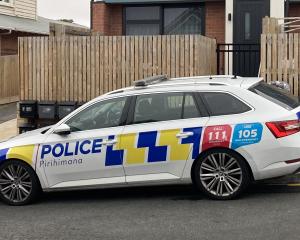
Former University of Otago information science lecturer Dr Colin Aldridge said his informal survey was far from scientifically robust, but published his findings anyway, because he was surprised at how many New Zealanders failed to recognise their own flag.
Dr Aldridge conducted the survey in Dunedin, Hastings and Havelock North during the Christmas-New Year holiday period, approaching pedestrians and showing them images of the proposed alternative New Zealand flag as Flag A, and the Australian flag as Flag B.
He then asked: "Which of these would you choose for the New Zealand flag?''
"Only 10% of those approached recognised the Australian flag for what it was.
"The 90% that didn't notice is not a number you can trust, speaking as a scientist. It should raise significant doubt.
"But I published the results because it's relevant to the current debate that a lot of people have difficulty distinguishing the New Zealand flag from the Australian flag.
"If I had put the Union Jack or the [Canadian] maple leaf or a few other distinctive flags, then there wouldn't have been any doubt about it in people's minds.
"They would have said: You're showing the Union Jack, why are you doing this?''
Dr Aldridge said the confusion between the New Zealand and Australian flags was a long-standing problem, and the results of his survey showed it was continuing.
The informal survey also found Dunedin respondents were the most observant, 16% of them recognising the Australian flag.
"In Havelock North, 11% correctly identified it, while in Hastings, only 4% did. The latter seemed to have a higher proportion of non-New Zealanders, though.''
Overall, 43% of respondents chose the proposed flag and 46% chose the Australian flag.
He said Dunedin was the most conservative. Only 27% of respondents selected the proposed flag.
In Hastings, nearly half of the respondents chose the new flag, and in Havelock North, 62% chose the new flag.
Dr Aldridge said he would personally like to see a new flag raised in New Zealand.
University of Otago Mathematics and Statistics Department head Prof Richard Barker said only 252 people responded to the survey, so they could not be regarded as a representative sample of New Zealanders.
"It was not robust in that sense.
"The methodology is such, that it cannot be regarded as a scientific poll.
"Strictly, these views can be taken only as the opinions of those sampled and can't be reliably extrapolated to the whole population.''
Prof Barker described the survey as "anecdotal'' and believed the statistics should be left for Otago Daily Times readers to decide for themselves, whether they were to be trusted or not.
The proposed new flag is now flying alongside the present New Zealand flag on the Auckland Harbour Bridge until March 24, when the flag referendum will be complete.
Deputy Prime Minister Bill English said it was one of more than 250 sites around the country to fly the flag.
"Having the two flags flying side by side around New Zealand will help people compare the designs before making a decision in the final flag referendum, which runs from March 3 to March 24.''











